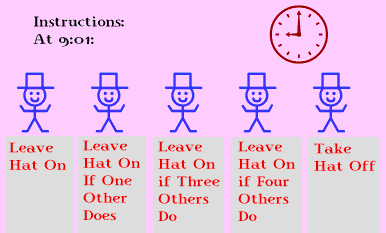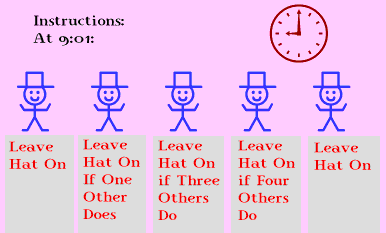Contingent Behavior
Contingent behavior exists when each person's actions depend on what he expects others to do. Its role is obvious in our day-to-day behavior. The way a person going to a party dresses will depend on how he expects others to dress. People select the time and place they eat lunch on expectations of when and where others will eat. The route a person takes to work depends on what routes he expects others to use. Students decide whether or not to cut a class before a vacation based on how many other students they expect to cut the class, and the amount they study for a test is often based on how much they expect other people to study.
The existence of unintended consequences in contingent behavior is illustrated in the pictures below. In both pictures, the behavior of the people involved depends on how they see others acting. You should be able to see that in the first picture below the end result will be that two people keep hats on.

The only difference in the second picture is that one person's instructions have changed. Although only one instruction has changed, the actions of three people are affected.

There is a multiplier effect in these pictures that is the source of the unintended consequence. Changing the instructions of one person changes the behavior of three. When one person changes behavior, it may cause still another to act differently, which in turn can cause still another to act differently. Thus, a small initial change may result in a large final change. The result can be unintended because people act while ignoring the effect that their behavior will have on the behavior of others.
The effects of contingent behavior seem commonplace in our day-to-day activity--peer pressure is but one example of it at work. However, economists have not spent much time with it because it is not directly based on the favorite assumption of economics, which is that behavior is based on a self-interested weighing of costs and benefits. There is, however, a good reason to develop the idea a bit further because that development is an easy way to introduce several ideas, such as equilibrium, behavioral assumptions, and an adjustment process, which are essential to understanding economic theory. The advantage of meeting them here is that, as with most ideas, they will be easier to understand when you see them in a variety of contexts.
Copyright Robert Schenk